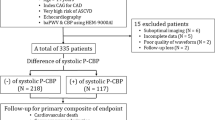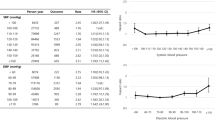Abstract
Patients with hypertension have an increased case fatality during acute myocardial infarction (MI). Coronary collateral (CC) circulation has been proposed to reduce the risk of death during acute ischaemia. We determined whether and to which degree high blood pressure (BP) affects the presence and extent of CC circulation. A cross-sectional study in 237 patients (84% males), admitted for elective coronary angioplasty between January 1998 and July 2002, was conducted. Collaterals were graded with Rentrop's classification (grade 0–3). CC presence was defined as Rentrop-grade ⩾1. BP was measured twice with an inflatable cuff manometer in seated position. Pulse pressure was calculated by systolic blood pressure (SBP)−diastolic blood pressure (DBP). Mean arterial pressure was calculated by DBP+1/3 × (SBP−DBP). Systolic hypertension was defined by a reading ⩾140 mmHg. We used logistic regression with adjustment for putative confounders. SBP (odds ratio (OR) 0.86 per 10 mmHg; 95% confidence interval (CI) 0.73–1.00), DBP (OR 0.67 per 10 mmHg; 95% CI 0.49–0.93), mean arterial pressure (OR 0.73 per 10 mmHg; 95% CI 0.56–0.94), systolic hypertension (OR 0.49; 95% CI 0.26–0.94), and antihypertensive treatment (OR 0.53; 95% CI 0.27–1.02), each were inversely associated with the presence of CCs. Also, among patients with CCs, there was a graded, significant inverse relation between levels of SBP, levels of pulse pressure, and collateral extent. There is an inverse relationship between BP and the presence and extent of CC circulation in patients with ischaemic heart disease.
This is a preview of subscription content, access via your institution
Access options
Subscribe to this journal
Receive 12 digital issues and online access to articles
$119.00 per year
only $9.92 per issue
Buy this article
- Purchase on Springer Link
- Instant access to full article PDF
Prices may be subject to local taxes which are calculated during checkout




Similar content being viewed by others
References
Njolstad I, Arnesen E . Preinfarction blood pressure and smoking are determinants for a fatal outcome of myocardial infarction: a prospective analysis from the Finnmark Study. Arch Intern Med 1998; 158: 1326–1332.
Koerselman J, van der Graaf Y, de Jaegere PP, Grobbee DE . Coronary collaterals: an important and underexposed aspect of coronary artery disease. Circulation 2003; 107: 2507–2511.
Seiler C . The human coronary collateral circulation. Heart 2003; 89: 1352–1357.
Popma JJ, Bittl J . Coronary angiography and intravascular ultrasonography. In: Braunwald E, Zipes DP, Libby P (eds). Heart Disease: A Textbook of Cardiovascular Medicine. WB Saunders Company: Philadelphia, 2001, pp 387–418.
Fukai M et al. Angiographically demonstrated coronary collaterals predict residual viable myocardium in patients with chronic myocardial infarction: a regional metabolic study. J Cardiol 2000; 35: 103–111.
Kornowski R . Collateral formation and clinical variables in obstructive coronary artery disease: the influence of hypercholesterolemia and diabetes mellitus. Coron Artery Dis 2003; 14: 61–64.
Kilian JG, Keech A, Adams MR, Celermajer DS . Coronary collateralization: determinants of adequate distal vessel filling after arterial occlusion. Coron Artery Dis 2002; 13: 155–159.
Fujita M et al. Determinants of collateral development in patients with acute myocardial infarction. Clin Cardiol 1999; 22: 595–599.
Kyriakides ZS et al. Coronary collateral circulation in coronary artery disease and systemic hypertension. Am J Cardiol 1991; 67: 687–690.
Karpanou EA et al. Significance of arterial hypertension on coronary collateral circulation development and left ventricular function in coronary artery disease. J Hypertens 1988; (Suppl 6): S151–S153.
Heinle RA, Levy RI, Gorlin R . Effects of factors predisposing to atherosclerosis on formation of coronary collateral vessels. Am J Cardiol 1974; 33: 12–16.
Simons PC et al. Second manifestations of ARTerial disease (SMART) study: rationale and design. Eur J Epidemiol 1999; 15: 773–781.
Rentrop KP, Cohen M, Blanke H, Phillips RA . Changes in collateral channel filling immediately after controlled coronary artery occlusion by an angioplasty balloon in human subjects. J Am Coll Cardiol 1985; 5: 587–592.
van Liebergen RA et al. Quantification of collateral flow in humans: a comparison of angiographic, electrocardiographic and hemodynamic variables. J Am Coll Cardiol 1999; 33: 670–677.
Rogers G, Oosthuyse T . A comparison of the indirect estimate of mean arterial pressure calculated by the conventional equation and calculated to compensate for a change in heart rate. Int J Sports Med 2000; 21: 90–95.
Kurotobi T et al. Reduced collateral circulation to the infarct-related artery in elderly patients with acute myocardial infarction. J Am Coll Cardiol 2004; 44: 28–34.
Habib GB et al. Influence of coronary collateral vessels on myocardial infarct size in humans. Results of phase I thrombolysis in myocardial infarction (TIMI) trial. The TIMI Investigators. Circulation 1991; 83: 739–746.
Rentrop KP, Thornton JC, Feit F, Van Buskirk M . Determinants and protective potential of coronary arterial collaterals as assessed by an angioplasty model. Am J Cardiol 1988; 61: 677–684.
Sabia PJ et al. An association between collateral blood flow and myocardial viability in patients with recent myocardial infarction. N Engl J Med 1992; 327: 1825–1831.
Seiler C, Fleisch M, Garachemani A, Meier B . Coronary collateral quantitation in patients with coronary artery disease using intravascular flow velocity or pressure measurements. J Am Coll Cardiol 1998; 32: 1272–1279.
Kyriakidis MK et al. Relation between changes in blood flow of the contralateral coronary artery and the angiographic extent and function of recruitable collateral vessels arising from this artery during balloon coronary occlusion. J Am Coll Cardiol 1994; 23: 869–878.
Meier B et al. Coronary wedge pressure in relation to spontaneously visible and recruitable collaterals. Circulation 1987; 75: 906–913.
Werner GS et al. Angiographic assessment of collateral connections in comparison with invasively determined collateral function in chronic coronary occlusions. Circulation 2003; 107: 1972–1977.
Buschmann I, Schaper W . The pathophysiology of the collateral circulation (arteriogenesis). J Pathol 2000; 190: 338–342.
Yilmaz MB et al. Obesity is associated with impaired coronary collateral vessel development. Int J Obes Relat Metab Disord 2003; 27: 1541–1545.
Lee CW et al. Temporal patterns of gene expression after acute hindlimb ischemia in mice: insights into the genomic program for collateral vessel development. J Am Coll Cardiol 2004; 43: 474–482.
Fujita M, Tambara K . Recent insights into human coronary collateral development. Heart 2004; 90: 246–250.
Miura S et al. Angiotensin-converting enzyme inhibitor promotes coronary collateral circulation in patients with coronary artery disease. Circ J 2003; 67: 535–538.
Heeschen C, Weis M, Cooke JP . Nicotine promotes arteriogenesis. J Am Coll Cardiol 2003; 41: 489–496.
Hochberg I et al. Haptoglobin phenotype and coronary artery collaterals in diabetic patients. Atherosclerosis 2002; 161: 441–446.
Nishikawa H et al. Pravastatin promotes coronary collateral circulation in patients with coronary artery disease. Coron Artery Dis 2002; 13: 377–381.
Nagai Y et al. Plasma level of homocysteine is inversely-associated with the development of collateral circulation in patients with single-vessel coronary artery disease. Circ J 2002; 66: 158–162.
Duan J et al. Hyperhomocysteinemia impairs angiogenesis in response to hindlimb ischemia. Arterioscler Thromb Vasc Biol 2000; 20: 2579–2585.
Piek JJ et al. Clinical, angiographic and hemodynamic predictors of recruitable collateral flow assessed during balloon angioplasty coronary occlusion. J Am Coll Cardiol 1997; 29: 275–282.
Newman PE . The coronary collateral circulation: determinants and functional significance in ischemic heart disease. Am Heart J 1981; 102: 431–445.
Sasayama S, Fujita M . Recent insights into coronary collateral circulation. Circulation 1992; 85: 1197–1204.
Henderson RD et al. Angiographically defined collateral circulation and risk of stroke in patients with severe carotid artery stenosis. North American Symptomatic Carotid Endarterectomy Trial (NASCET) Group. Stroke 2000; 31: 128–132.
Boudier HA . Hypertension and microcirculation. Arch Mal Coeur Vaiss 2002; 95 (Spec No 6): 17–22.
Boudier HA . Arteriolar and capillary remodelling in hypertension. Drugs 1999; 58 (Spec No 1): 37–40.
Vicaut E . Microcirculation and arterial hypertension. Drugs 1999; 58 (Spec No 1): 1–10.
Wong TY et al. Prospective cohort study of retinal vessel diameters and risk of hypertension. BMJ 2004; 329: 79.
Acknowledgements
These data were presented previously in part as a poster, entitled ‘High blood pressure is inversely related with presence and extent of coronary collaterals’, at the 14th European Meeting on Hypertension of the European Society of Hypertension 2004 (Paris, France). We gratefully acknowledge Koos (J) Plomp, Cardiologist, Department of Cardiology, Heart Lung Center Utrecht, UMC Utrecht, Utrecht, The Netherlands, for scoring the 100 coronary angiograms to assess interobserver variability of the collateral grading. We thank Michael Edlinger for his accurate handling of the SMART-data. We thank Prof Harry AJ Struijker Boudier, PhD, for critical revision of the manuscript. We thank Christine AE Broeders for her excellent secretarial assistance. The work presented in this paper is part of a program grant from the Netherlands Organisation for Health Research and Development (ZonMw, project number 904-65-095). This funding source had no involvement in the writing of this paper or its submission. MCV is supported by the Netherlands Organisation for Scientific Research (NWO, Grant number 016-036-041).
Author information
Authors and Affiliations
Consortia
Corresponding author
Additional information
Conflict of interest statement: None.
Appendix
Appendix
The SMART Study Group consists of A Algra, MD, PhD, Y van der Graaf, MD, PhD, DE Grobbee, MD, PhD, GEHM Rutten, MD, PhD, Julius Center for Health Sciences and Primary Care, JD Banga, MD, PhD, FLJ Visseren, MD, PhD, Department of Internal Medicine, BC Eikelboom, MD, PhD, FL Moll, MD, PhD, Department of Vascular Surgery, LJ Kappelle, MD, PhD, Department of Neurology, HA Koomans, MD, PhD, Department of Nephrology, WPThM Mali, MD, PhD, Department of Radiology, PAFM Doevendans, MD, PhD, and PPTh de Jaegere, MD, PhD, Department of Cardiology, University Medical Center Utrecht, Utrecht, The Netherlands.
Rights and permissions
About this article
Cite this article
Koerselman, J., de Jaegere, P., Verhaar, M. et al. High blood pressure is inversely related with the presence and extent of coronary collaterals. J Hum Hypertens 19, 809–817 (2005). https://doi.org/10.1038/sj.jhh.1001917
Received:
Revised:
Accepted:
Published:
Issue Date:
DOI: https://doi.org/10.1038/sj.jhh.1001917
Keywords
This article is cited by
-
Non-high-density lipoprotein cholesterol/high-density lipoprotein cholesterol ratio serve as a predictor for coronary collateral circulation in chronic total occlusive patients
BMC Cardiovascular Disorders (2021)
-
Reduced coronary collateralization in type 2 diabetic patients with chronic total occlusion
Cardiovascular Diabetology (2018)
-
Cardiovascular risk factors cause premature rarefaction of the collateral circulation and greater ischemic tissue injury
Angiogenesis (2015)
-
Predictor of poor coronary collaterals in chronic kidney disease population with significant coronary artery disease
BMC Nephrology (2012)
-
Is there an association between hypertension and the development of coronary collateral flow?
Journal of Human Hypertension (2005)



